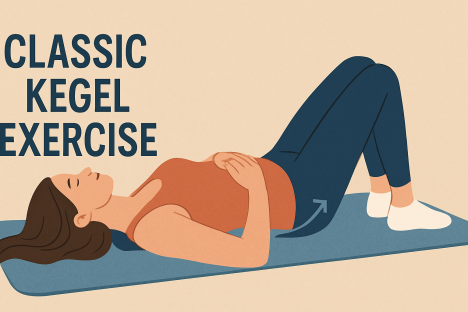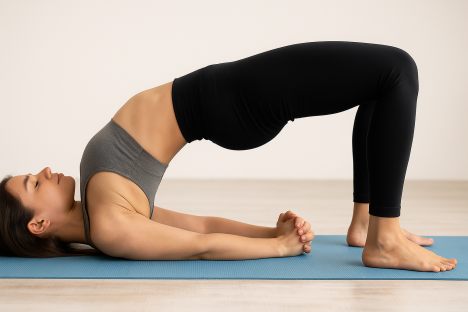The morning you first notice a change in your intimate wellness, a quiet concern settles in. Maybe it’s during a laugh that catches you off guard, or in a moment of intimacy when things don’t feel quite the same.
You’re not alone in this experience, and more importantly, you have the power to make positive changes starting today.
Millions of women across America face changes in their pelvic floor strength throughout their lives. Whether due to childbirth, aging, hormonal changes, or simply the natural course of life, these changes are completely normal. What’s empowering is knowing that targeted exercises can help restore strength, confidence, and comfort.
This comprehensive guide will walk you through the most effective vaginal tightening exercises, backed by medical research and designed specifically for busy American women who want real results. We’ll explore everything from basic Kegel exercises to advanced techniques, helping you build a routine that fits your lifestyle and goals.
Understanding Your Pelvic Floor: The Foundation of Intimate Health
Your pelvic floor is a remarkable network of muscles, ligaments, and tissues that form a supportive hammock at the bottom of your pelvis. These muscles support your bladder, uterus, and rectum while playing a crucial role in sexual function, bladder control, and core stability.
Think of your pelvic floor as the foundation of a house. When it’s strong and well-maintained, everything above it functions properly. When it weakens, you might experience issues like urinary incontinence, reduced sexual sensation, or pelvic organ prolapse.
The good news? These muscles respond beautifully to exercise, just like any other muscle group in your body. With consistent training, most women see significant improvements in strength, control, and overall comfort within 6-8 weeks.
Why Pelvic Floor Muscles Weaken

Several factors can contribute to pelvic floor weakness:
Pregnancy and Childbirth: The weight of a growing baby and the birthing process can stretch and weaken these muscles. Both vaginal delivery and C-section can affect pelvic floor strength, though vaginal delivery typically has a more immediate impact.
Aging and Hormonal Changes: As estrogen levels decline during menopause, muscle tone naturally decreases. This affects the pelvic floor along with other muscle groups throughout the body.
Chronic Coughing or Straining: Conditions like chronic bronchitis, constipation, or heavy lifting can put repeated pressure on the pelvic floor, leading to gradual weakening.
Obesity: Extra weight increases pressure on the pelvic floor muscles, potentially leading to weakness over time.
High-Impact Activities: Years of high-impact exercise without proper pelvic floor conditioning can contribute to muscle fatigue and weakness.
The Science Behind Vaginal Tightening Exercises
Medical research consistently shows that pelvic floor muscle training is highly effective for improving vaginal tone and overall pelvic health. A study published in the International Journal of Gynecology & Obstetrics found that women who performed regular pelvic floor exercises experienced significant improvements in muscle strength and sexual function within 12 weeks.
The key lies in understanding that “tightening”; isn’t just about making muscles contract harder-it’s about improving their overall function. Healthy pelvic floor muscles should be both strong and flexible, able to contract when needed and relax when appropriate.
When you perform these exercises correctly, you’re:
- Increasing blood flow to the pelvic region
- Improving muscle coordination and control
- Building endurance for sustained muscle function
- Enhancing the connection between your brain and pelvic muscles
Essential Vaginal Tightening Exercises: Your Complete Routine
1. Classic Kegel Exercises: The Foundation Movement

Kegel exercises remain the gold standard for pelvic floor strengthening. Named after Dr. Arnold Kegel who developed them in the 1940s, these exercises specifically target the muscles that support your pelvic organs.
How to Perform Kegels:
- Find the Right Muscles: Imagine stopping the flow of urine midstream or preventing gas from escaping. The muscles you engage are your pelvic floor muscles.
- Perfect Your Position: You can do Kegels lying down, sitting, or standing. Start in whatever position feels most comfortable.
- Contract and Hold: Tighten your pelvic floor muscles and hold for 3-5 seconds. Focus on lifting the muscles up and in, not pushing down.
- Release and Rest: Relax the muscles for 3-5 seconds between contractions.
- Repeat: Start with 10 repetitions, three times daily.
Progressive Training Schedule:
- Week 1-2: Hold for 3 seconds, rest for 3 seconds
- Week 3-4: Hold for 5 seconds, rest for 5 seconds
- Week 5-6: Hold for 8 seconds, rest for 8 seconds
- Week 7+: Hold for 10 seconds, rest for 10 seconds
2. Fast-Twitch Kegels: Building Quick Response
While traditional Kegels focus on endurance, fast-twitch Kegels improve your muscles’ ability to respond quickly to sudden pressure increases (like coughing or sneezing).
Technique:
- Contract your pelvic floor muscles as quickly and strongly as possible
- Release immediately
- Rest for 2 seconds
- Repeat 10-15 times
Perform 2-3 sets of fast-twitch Kegels daily alongside your regular Kegel routine.
3. Bridge Pose with Kegel Integration

This exercise combines core strengthening with pelvic floor activation, creating a more functional movement pattern.
Steps:
- Lie on your back with knees bent, feet flat on the floor
- Engage your pelvic floor muscles
- Lift your hips while maintaining the pelvic floor contraction
- Hold for 5-10 seconds
- Lower slowly while keeping pelvic muscles engaged
- Repeat 10-15 times
4. Modified Squats for Pelvic Floor Strength
Squats engage your entire core, including the pelvic floor, while building functional strength.
Proper Form:
- Stand with feet shoulder-width apart
- Engage your pelvic floor muscles before beginning the movement
- Lower into a squat while maintaining pelvic floor activation
- Keep your chest up and weight in your heels
- Rise slowly, focusing on using your pelvic floor to help stabilize
- Perform 12-15 repetitions
5. Wall Sits with Pelvic Focus

This isometric exercise builds endurance in both your leg muscles and pelvic floor.
Technique:
- Stand with your back against a wall
- Slide down until your thighs are parallel to the floor
- Engage your pelvic floor muscles and hold
- Breathe normally while maintaining the contraction
- Hold for 30-60 seconds
- Repeat 3-5 times
6. Dead Bug Exercise for Core Integration
This exercise teaches you to maintain pelvic floor engagement while moving your limbs-a crucial skill for daily activities.
Instructions:
- Lie on your back with arms extended toward the ceiling
- Lift your knees to 90 degrees
- Engage your pelvic floor and core muscles
- Slowly lower one arm and the opposite leg toward the floor
- Return to starting position while maintaining engagement
- Alternate sides for 10 repetitions each
7. Bird Dog for Functional Strength
This exercise challenges your pelvic floor while improving overall core stability.
Steps:
- Start on hands and knees
- Engage your pelvic floor muscles
- Extend your right arm and left leg simultaneously
- Hold for 5-10 seconds while maintaining pelvic floor engagement
- Return to center and switch sides
- Perform 8-10 repetitions per side
Advanced Techniques for Maximum Results
Progressive Resistance Training
Once you’ve mastered basic exercises, you can add resistance to increase the challenge:
Vaginal Weights: These cone-shaped weights are inserted into the vagina, and your pelvic floor muscles work to hold them in place. Start with the lightest weight and gradually increase as your strength improves.
Resistance Bands: Use resistance bands during squats or other exercises to add extra challenge to your pelvic floor muscles.
Biofeedback Training
Biofeedback devices can help you better understand and control your pelvic floor muscles. These tools provide visual or auditory feedback about muscle activity, helping you perfect your technique.
Functional Movement Integration
The goal isn’t just to have strong pelvic floor muscles in isolation-you want them to work properly during daily activities. Practice engaging your pelvic floor during:
- Lifting objects
- Coughing or sneezing
- Laughing
- Exercise activities
- Intimate moments
Creating Your Personal Exercise Schedule
Consistency is key to seeing results. Here’s a sample weekly schedule that you can adapt to your lifestyle:
Monday, Wednesday, Friday (Full Routine):
- 3 sets of traditional Kegels (10 reps each)
- 2 sets of fast-twitch Kegels (15 reps each)
- Bridge pose with Kegels (15 reps)
- Modified squats (12 reps)
- Dead bug exercise (10 reps each side)
Tuesday, Thursday (Maintenance):
- 2 sets of traditional Kegels (10 reps each)
- Wall sits with pelvic focus (30-60 seconds)
- Bird dog exercise (8 reps each side)
Saturday (Active Recovery):
- Gentle stretching
- Yoga poses that support pelvic health
- 1 set of traditional Kegels
Sunday (Rest):
- Complete rest or gentle walking
Common Mistakes to Avoid
Even with the best intentions, it’s easy to make mistakes that can hinder your progress or even cause problems:
Over-Exercising
More isn’t always better. Your pelvic floor muscles need time to recover just like any other muscle group. Excessive exercising can lead to muscle fatigue and tension.
Holding Your Breath
Many women hold their breath during pelvic floor exercises. This creates unnecessary tension and reduces the effectiveness of the exercise. Focus on breathing normally throughout each movement.
Using the Wrong Muscles
It’s common to accidentally engage your buttocks, thighs, or abdominal muscles instead of your pelvic floor. Take time to isolate the correct muscles before adding intensity.
Ignoring the Release Phase
The relaxation phase between contractions is just as important as the contraction itself. Muscles that can’t relax properly can become overly tight and dysfunctional.
Expecting Immediate Results
Building muscle strength takes time. Most women notice initial improvements within 2-4 weeks, with significant changes occurring after 6-8 weeks of consistent practice.
Lifestyle Factors That Support Pelvic Health
Exercise is just one piece of the puzzle. Several lifestyle factors can enhance the effectiveness of your vaginal tightening routine:
Maintain a Healthy Weight
Excess weight puts additional pressure on your pelvic floor muscles. Even a modest weight loss can significantly reduce this pressure and improve muscle function.
Stay Hydrated
Proper hydration supports healthy tissue function and can help prevent urinary tract infections that might complicate your exercise routine.
Manage Constipation
Chronic straining during bowel movements can weaken pelvic floor muscles. Ensure adequate fiber intake and hydration to maintain regular, comfortable bowel movements.
Consider Hormonal Health
If you’re experiencing menopause-related changes, discuss hormone therapy options with your healthcare provider. Adequate estrogen levels support healthy muscle and tissue function.
Practice Good Posture
Poor posture can negatively affect pelvic floor function. Focus on maintaining neutral spine alignment throughout your day.
When to Seek Professional Help
While many women can successfully strengthen their pelvic floor muscles on their own, certain situations warrant professional guidance:
Consider consulting a pelvic floor physical therapist if you experience:
- Pain during pelvic floor exercises
- No improvement after 8-12 weeks of consistent exercise
- Symptoms of pelvic organ prolapse
- Persistent urinary incontinence
- Pain during intercourse
- Chronic pelvic pain
A specialized physical therapist can assess your specific needs, identify any muscle imbalances, and create a personalized treatment plan.
Measuring Your Progress
Tracking your progress helps maintain motivation and ensures you’re moving in the right direction. Consider these methods:
Subjective Measures
- Keep a daily journal noting how your symptoms feel
- Rate your comfort level during intimate activities
- Track your confidence in social situations
- Monitor bladder control during activities like coughing or exercising
Objective Measures
- Time how long you can hold a Kegel contraction
- Count how many repetitions you can perform before fatigue
- Note any reduction in accidental urine leakage
- Track improvements in your ability to stop urination midstream
Professional Assessment
If you’re working with a healthcare provider, they might use:
- Vaginal pressure measurements
- Ultrasound imaging to assess muscle function
- Standardized questionnaires about symptoms and quality of life
Nutrition for Pelvic Floor Health
What you eat can impact the health and function of your pelvic floor muscles:
Anti-Inflammatory Foods
Chronic inflammation can interfere with muscle function and healing. Include plenty of:
- Leafy green vegetables
- Fatty fish rich in omega-3s
- Berries and other antioxidant-rich fruits
- Nuts and seeds
Adequate Protein
Your muscles need protein to repair and strengthen. Aim for:
- Lean meats, poultry, and fish
- Legumes and beans
- Greek yogurt and cottage cheese
- Eggs
Limit Bladder Irritants
Certain foods and drinks can irritate the bladder and worsen symptoms:
- Excessive caffeine
- Alcohol
- Spicy foods
- Artificial sweeteners
The Mind-Body Connection
Your mental and emotional state can significantly impact your physical health, including pelvic floor function:
Stress Management
Chronic stress can cause muscle tension throughout your body, including your pelvic floor. Incorporate stress-reduction techniques such as:
- Deep breathing exercises
- Meditation or mindfulness practices
- Regular physical activity
- Adequate sleep
Body Awareness
Developing a better connection with your body can improve your ability to control your pelvic floor muscles. Practice:
- Body scan meditations
- Mindful movement exercises
- Progressive muscle relaxation
Positive Self-Talk
Many women feel embarrassed or frustrated about pelvic floor issues. Remember that these concerns are incredibly common and treatable. Practice self-compassion and focus on the positive changes you’re making.
Long-Term Maintenance and Prevention
Once you’ve achieved your initial goals, maintaining your results requires ongoing attention:
Maintenance Exercise Schedule
After reaching your strength goals, you can typically maintain your results with:
- 3-4 sets of Kegels, 3 times per week
- One functional exercise session per week
- Regular attention to posture and body mechanics
Adapt to Life Changes
Your pelvic floor needs may change throughout your life. Be prepared to adjust your routine during:
- Pregnancy and postpartum recovery
- Menopause
- Periods of increased stress
- Changes in activity level or health status
Annual Check-Ins
Consider annual pelvic floor assessments with a healthcare provider, especially if you have a history of pelvic floor dysfunction.
Success Stories and Realistic Expectations
Understanding what to expect can help you stay motivated throughout your journey:
Timeline for Results
- 2-3 weeks: Many women notice initial improvements in awareness and control
- 4-6 weeks: Strength gains become more apparent
- 8-12 weeks: Significant improvements in symptoms and function
- 3-6 months: Maximum benefits typically achieved
Individual Variation
Remember that everyone’s body responds differently to exercise. Factors that can influence your results include:
- Starting fitness level
- Age and hormonal status
- Severity of initial symptoms
- Consistency with exercise routine
- Overall health status
Conclusion: Your Journey to Better Pelvic Health
Strengthening your pelvic floor muscles through targeted exercises is one of the most effective ways to improve your intimate health and overall quality of life. The journey requires patience, consistency, and self-compassion, but the rewards-increased confidence, better bladder control, enhanced intimacy, and improved overall wellness-are well worth the effort.
Remember that every woman’s body is unique, and what works best for one person may need adjustment for another. Start with the basic exercises outlined in this guide, listen to your body, and don’t hesitate to seek professional guidance when needed.
Your pelvic health is an important aspect of your overall wellness that deserves attention and care. By incorporating these exercises into your routine and adopting the supporting lifestyle practices discussed, you’re taking a proactive step toward better health and increased confidence.
Begin your journey today with just a few minutes of daily exercise. Your future self will thank you for the investment you’re making in your health and well-being. With consistency and patience, you can achieve the strength, control, and confidence you desire.
The power to improve your pelvic health is literally in your hands-or more accurately, in your dedicated practice of these proven exercises. Start where you are, use what you have, and do what you can. Every contraction brings you one step closer to your goals.








